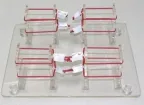The superficial knotting skill training model plays an important role in the training of clinical medical staff. It can not only provide an intuitive and real operating environment, but also effectively improve the knotting skills of medical staff and the proficiency of surgical operations. The following is a detailed explanation of how to support the training of clinical healthcare staff:

Provide realistic simulation environment:
Using advanced materials and techniques, the superficial knotting skills training model can simulate the texture and tension of human tissues, providing a highly realistic knotting training environment for medical personnel. This simulation environment can help the medical staff to better understand and master the knotting skills, improve the accuracy and efficiency of the operation.
Support a variety of knot training methods:
The model supports the training of multiple knotting methods, including one-handed knotting, two-handed knotting, continuous knotting and so on. Medical staff can choose the appropriate knotting method for practice according to their own needs and surgical requirements. This variety of training methods helps to improve the flexibility and resilience of medical staff.
Simulated vascular tone regulation:
The superficial knotting skill training model also has the function of simulating vascular tension. The medical staff can simulate the knotting operation in different situations by adjusting the tension of the model. This simulation function helps medical staff to better adapt to various changes during surgery and improve their ability to cope with complex situations.
Improve operational skills and proficiency:
Through repeated practice using the superficial knotting skills training model, the knotting skills of medical staff and the proficiency of surgical operations will be significantly improved. This improvement not only helps reduce the risk of errors and injuries during surgery, but also improves the efficiency and quality of surgery and provides better medical services to patients.
Promote teamwork and communication:
When using the superficial knotting skills training model, medical staff can collaborate, exchange ideas and skills. This kind of teamwork and communication can promote knowledge sharing and experience accumulation among medical staff, and improve the level and capability of the entire medical team.
In summary, the superficial knotting skills training model effectively supports the training of clinical health care personnel by providing a realistic simulation environment, supporting the training of multiple knotting methods, simulating vascular tension regulation, improving operational skills and proficiency, and promoting team cooperation and communication.
